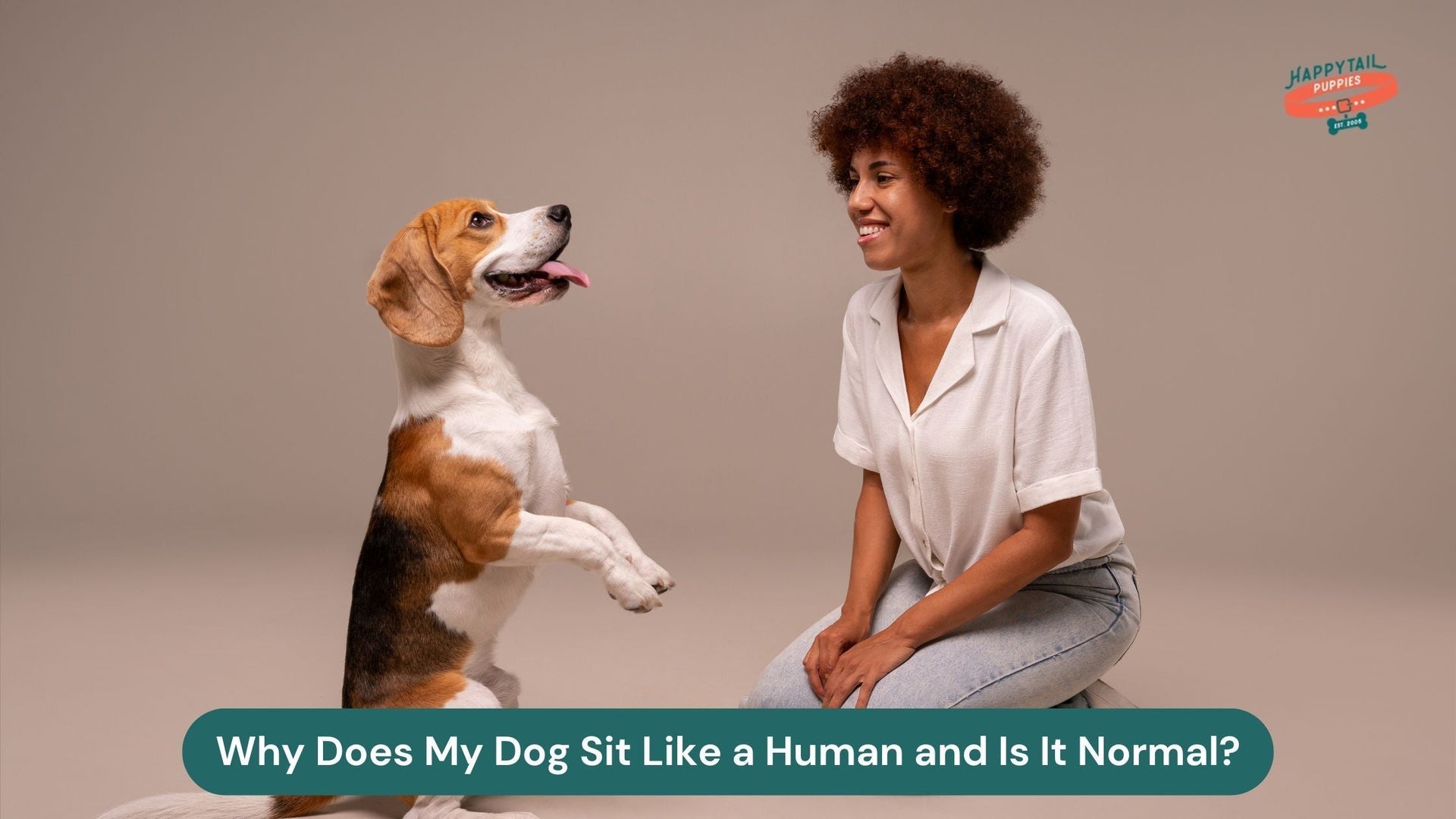Why Does My Dog Sit Like a Human and Is It Normal?
Your dog sitting like a human is usually comfy or learned behavior. Watch for stiffness/limping; it may signal joint pain like hip dysplasia. See a vet if concerned.
🐾Table of Contents
- The Anatomy of a Dog’s Sitting Posture
- Common Reasons Dogs Sit Like Humans
- When Sitting Like a Human Might Signal a Problem
- How to Tell If Your Dog’s Sitting Posture Is Normal
- Is It Normal? The Behavioral and Emotional Perspective
- How to Support Your Dog’s Joint and Muscle Health
- When to Seek Professional Advice
- Conclusion
You look into your living room, and there’s your dog, stretched out on the couch, fully relaxed, and paws up, almost human-like. It really is an adorable sight, and it will undoubtedly bring a smile to your face.
Then, you start to wonder. Is it merely quirky and cute, or perhaps there’s a greater meaning to your dog’s relaxation behavior concerning comfort and health issues? It usually should not be a problem, but understanding this quirky behavior will help you get to know your dog better. So, why does my dog sit like a human, and what does it mean?
The Anatomy of a Dog’s Sitting Posture
Skeletal Structure
To be able to adopt multiple sitting postures, a dog’s skeleton must have flexibility and agility. The dog's spine and hips have enough range, balance, and comfort to allow a post extensive range of balance and comfort. Different postures can be adopted without causing strain.
Hip Alignment
The position and health of a dog’s hip joints will define how comfortably a dog can sit. Tightness or misalignment may cause odd postures that, to an untrained eye, may look unusual but are actually adaptations to ensure stability and minimize pain. Compact, round-bodied breeds like the Bichon Frise will sometimes sit differently due to their bone structure.
Muscle Flexibility
Strong core and thigh muscles allow dogs to maintain positions, whether relaxed or upright, seamlessly. These attributes also assist in maintaining the correct posture and avoiding excess strain on the lower back and hips.
Center of Gravity
The distribution of a dog’s weight makes it possible for them to maintain a sitting balance. Sitting balance is also achieved through proper alignment of the spine, legs, and base of the tail, which ultimately determines whether the dog is seated in a typical manner or lounging upright on cushioned surfaces.
Human-Like Sitting
Muscle tone and joint flexibility are demonstrated when dogs sit in a human position. Such a posture is evidence of balance, adaptability, and a mix of various comfort levels. According to the American Kennel Club (AKC), more than 60% of dog owners report that their dogs display human-like behaviors, such as upright sitting and other actions that mimic human gestures.
Common Reasons Dogs Sit Like Humans
There are many possible reasons why dogs assume this position, be it ease, imitation, or bodily needs. In this case, dogs will assume this position due to comfort, curiosity, or a basic medical need. Here are the most common reasons.
Comfort and Relaxation
Following an extended play or walking session, a dog might sit in a position that seems to suggest a sense of ease. Having a couch or other soft surface to lounge on encourages a dog to adopt a position that corresponds to human dispositions.
For some dogs, this pose helps them relax, achieve a rest state, and dissociate from their surroundings in an observant state. If a dog consistently chooses this position on a soft overstuffed couch, it suggests their nervous system is used to dialing down in that position.
Learned or Imitative Behavior
Dogs are observant, and they naturally imitate their owner, which for a dog might result in a learned or imitative behavior. When dogs imitate humans in a relaxed sitting pose, it is often interpreted as attention-seeking behavior.
Over time, a dog learns to receive rewards for this pose, which, to an owner, might be an endearing behavior. It illustrates an understanding on both sides.
Cooling Off or Temperature Regulation
Dogs may sit like humans to help air circulate around their belly or chest. On warm days, this upright position reduces body contact with hot surfaces.
For breeds with dense coats, it’s a convenient way to cool off naturally. Incorporating basic puppy commands such as “sit” and “stay” can also help you monitor your dog’s comfort level and posture during training sessions, especially in warmer climates.
Expression of Personality or Mood
Every dog has unique quirks, and posture is one of them. A confident, playful, or curious pup might choose to sit upright to observe everything happening around them.
This “human-like” stance shows self-assurance and emotional engagement with their environment. It can also be your dog’s way of interacting, saying, “I’m part of the action too!”
Habit from Puppyhood
Puppies sometimes discover this position accidentally while learning balance and coordination. If owners find it amusing, they often encourage it unknowingly through laughter or treats. Breeds like the Cavapoo, known for their playful and affectionate nature, often carry such habits into adulthood.
As the puppy grows, the habit sticks and evolves into a signature sitting style. For many adult dogs, it’s simply a nostalgic holdover from their playful, exploratory puppy days—a harmless, enduring quirk.
When Sitting Like a Human Might Signal a Problem
Many dogs sit upright when resting simply for comfort, but sudden or prolonged changes in that position may indicate health issues that need to be addressed. The manner in which your dog sits and the frequency with which they do so may inexorably point to potential problems that need to be solved.
Hip Dysplasia
Hip dysplasia is when a dog’s hip joint does not fit properly in its socket. This can cause a range of pain, stiffness, and movement issues. A dog in this postural pain may prefer to sit up and not bend their hind legs. The American Veterinary Medical Association (AVMA) also explains that medium to large-breed dogs suffer from hip dysplasia, ranging from mild to severe.
To prevent further issues like arthritis, it is important to address mobility issues. Early veterinary diagnosis, weight, and a balanced diet will help manage symptoms. Dogs need regular, but gentle, exercise to prevent loss of flexibility and to ease strain on weak joints.
Arthritis or Joint Pain
Older dogs can have arthritis or joint pain. It may become uncomfortable for them to sit, stand, or walk. The inflammation surrounding the joints may lead to stiffness and tenderness, making an upright sitting position preferred. Dogs can be in pain if they are favoring an upright sitting position. Stiff and painful joints can lead to owners seeking natural arthritis remedies for their pets, such as omega-3 supplements, joint chews, or therapeutic massages.
Some indications of arthritis in dogs may include, and are not limited to, delayed sitting or struggling to rise. Pain can be eased with anti-inflammatory medication, joint supplements, and implementing gently increasing physical activity. Weight management may be necessary to relieve pressure on the joints and maintain mobility.
Muscle Weakness or Injury
In some cases, poorly conditioned or damaged muscle tissue may compromise a dog’s ability to assume a particular position, leading the dog to sit and lean forward to assist with balance. This posture is typically assumed after minor sprains or after a dog has been overworked. Extreme caution is warranted when attempting to engage small and delicate breeds, such as a Teacup Pomeranian, in physical activities, as they are much more prone to muscle strain.
Signs such as the absence of a particular activity, disinterest in specific movements, uncoordinated movements, or quickly succumbing to exhaustion may suggest a dog is experiencing muscle pain and is compensating for it. Physiotherapy, vet-directed and graded exercises, and rest should assist in the recovery. The use of low-impact activities for muscle strengthening will ensure stability and confidence restoration while avoiding over-stressing damaged areas.
Spinal or Nerve Issues
Dogs with such spinal problems as misalignment or nerve compression may demonstrate particular postures, such as sitting. A dog may assume an upright position as a means of relieving spinal pain. The Canine Health Foundation has documented that spinal problems in dogs comprise nearly 14% of all cases of canine neural disorders.
Dragging paws, spineline sensitivity, or reluctance to climb or jump can all indicate a serious spinal neurological issue. The only way to improve the dog’s discomfort, posture, and mobility is through timely and effective veterinary assessment, including neurologic workup and relevant images, and physical rehabilitation. This will prevent the condition from impairing the dog’s posture and mobility.
Obesity and Weight Strain
Carrying excess weight adds extra strain on the joints and bones, making ordinary sitting positions painful. Overweight dogs usually assume upright or lounging postures to relieve the added strain. Also, the impact of obesity on the lifespan and the development of joint-related diseases makes it critical to know the dangers of dog obesity.
To achieve a healthy body weight, it is essential to properly manage diet, control portions, and engage in daily exercise. Incorporating controlled, regular walks, swimming, and vet-approved exercise outlines can help relieve joint strain and improve sitting posture. Weight management improves the dog’s comfort and quality of life and extends its longevity.
Postural Problems After Injuries or Surgery
Dogs will also change their sitting posture after injuries or surgery to avoid areas of the body that need to heal. Sitting upright or sideways is a way to relieve pressure from sensitive areas passively. The American Animal Hospital Association (AAHA) notes that properly structured post-surgical rehab plans can improve recovery outcomes by up to 40%.
If your dog is exhibiting behaviors suggesting reluctance to move or to assume certain positions, give them adequate time to heal. Ensure you comply with the vet’s recovery plan concerning rest, medications, and gentle rehab exercises. Sufficient post-care will result in a smoother recovery and help prevent new injuries.
Genetic or Structural Conditions
Some dog breeds are built differently and tend to sit in unusual positions. These small dog breeds tend to sit in a human-like manner with no strain.
While this comical position can range from harmless to concerning, differentiating discomfort from structurally natural positions is crucial. Regular vet check-ups help determine whether hidden structural issues or breed traits are the reasons for the particular sitting styles. Early identification and active management of care help prevent discomfort from chronic joint conditions.
How to Tell If Your Dog’s Sitting Posture Is Normal
- Frequency: An occasional seated posture is human-like and harmless. However, frequent and sudden posture changes are an indicator of possible discomfort and joint problems that may need intervention.
- Mobility: Signs of pain and restricted mobility may be present in your dog if you notice limping, stiffness, or hesitation when transitioning between sitting and standing.
- Symmetry: Joint pain or discomfort may be present if there is an imbalance when standing or sitting, such as one leg stretched out further than the other.
- Behavior: A dog is healthy when he or she rises with ease and flows freely into the next activity after sitting, without stiffness or reluctance during play.
- Comfort Cues: Sluggish and rigid posture may be an indicator of pain. Signs such as relaxed ears, soft eyes, and tail wagging are signs of comfort.
Note: Prior to assuming the behavior is simply playful or concerning from a medical standpoint, always consider your dog’s age, breed, and weight.
Is It Normal? The Behavioral and Emotional Perspective
- Behavioral Normalcy: Most dogs are a little relaxed around humans, and it's natural for them to comfortably adopt this posture once in a while. Curiosity or just plain comfort could be factors to aid this.
- Emotional Cues: A dog sitting like a human could be a trusting dog, comfortable in its surroundings. This could also be a way to seek attention or imitate some of their owner's human behavior, thereby strengthening their emotional bond.
- Trust and Comfort: Dogs that feel safe and content often display relaxed, open postures, including upright sitting, as a sign of confidence in their environment. You may also notice gentle dog tail wagging, soft eyes, and calm breathing—clear signs of emotional ease and security.
- Attention-Seeking: Some dogs learn that sitting upright gets laughs or affection, turning it into a social tool for interaction.
- Expert Insight: Trainers explain that this behavior, when pain-free, indicates a relaxed, confident, and well-socialized dog — one that feels secure and connected to its family.
How to Support Your Dog’s Joint and Muscle Health
Routine, straightforward practices can help prevent stiffness and pain and avoid severe orthopedic issues in the future.
- Balanced Nutrition: Provide premium quality dog food with adequate levels of omega-3 fatty acids, glucosamine, and chondroitin, which improve muscle tone and nourish the cartilage and joints for a lifetime.
- Regular Exercise: Regularly include calm, moderate, and low-impact exercises to help with muscle strengthening and flexibility. Inactivity and overexertion can lead to stiffness of the joints.
- Healthy Weight: Maintain your dog’s weight at a healthy level to cut down pressure on the spine, hips, and knees, thus lowering the possibility of arthritis and other complications of the joints.
- Supportive Bedding: Orthopedic and memory foam beds that alleviate pressure, aid contouring, and provide structural and positional support enhance restful sleep.
- Routine Vet Checkups: Regular visits to the veterinarian help assess and early identify stiffness and maintain joint health. Personalized advice and preventive measures for stiffness and joint problems can be obtained.
When to Seek Professional Advice
- Sudden changes in your dog's sitting style that concern you in the absence of a comfort preference warrant a visit to your vet.
- Lameness, stiffness, or a refusal to sit, stand, or move within normal ranges are symptoms that, together or separately, are cause to notify your vet.
- Persistent discomfort with an erect sitting posture, visible swelling, or joint pain needs attention and also encourages you to initiate a vet visit.
- Avoiding play and losing interest in their normal routine, do not participate in the exercise that your dog has previously shown enjoyment in, which warrants professional attention.
- If posture problems are also associated with a low mood, a refusal to eat, or extreme lethargy, visit your vet.
Conclusion
When a dog sits in a human position, it's often because the dog is simply comfortable, curious, or showing personality. Many dogs naturally assume this position or use it to relax. When discomfort or a change in posture is noted, there is a strong need for a veterinarian to examine your pup.
All dogs are unique, and each of their moves should be celebrated—some will curl up like a puppy, others will sprawl like a person. Even slight changes in posture can indicate their mood, trust, and comfort. Identifying these unique behaviors will strengthen the bond between you and your dog and improve their quality of life.


